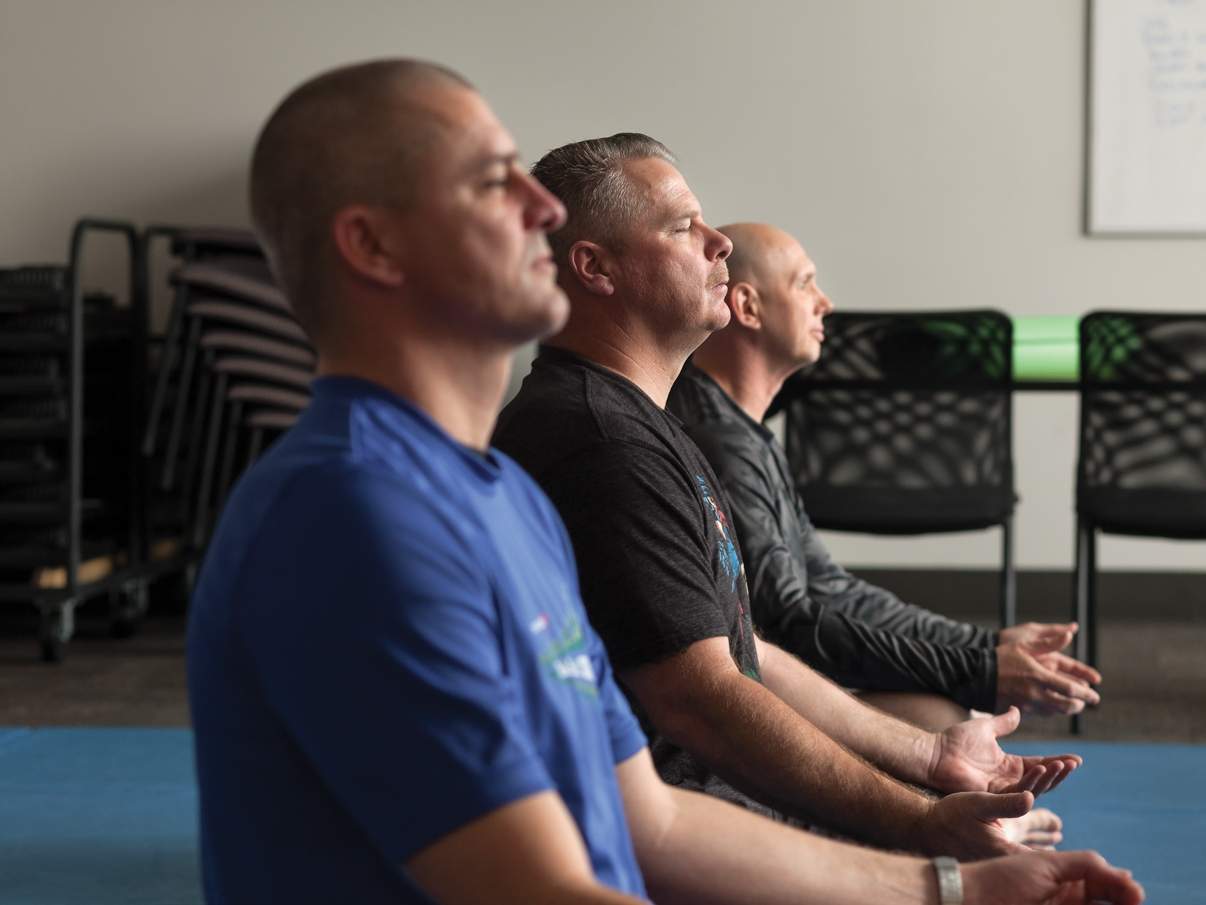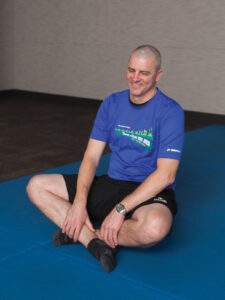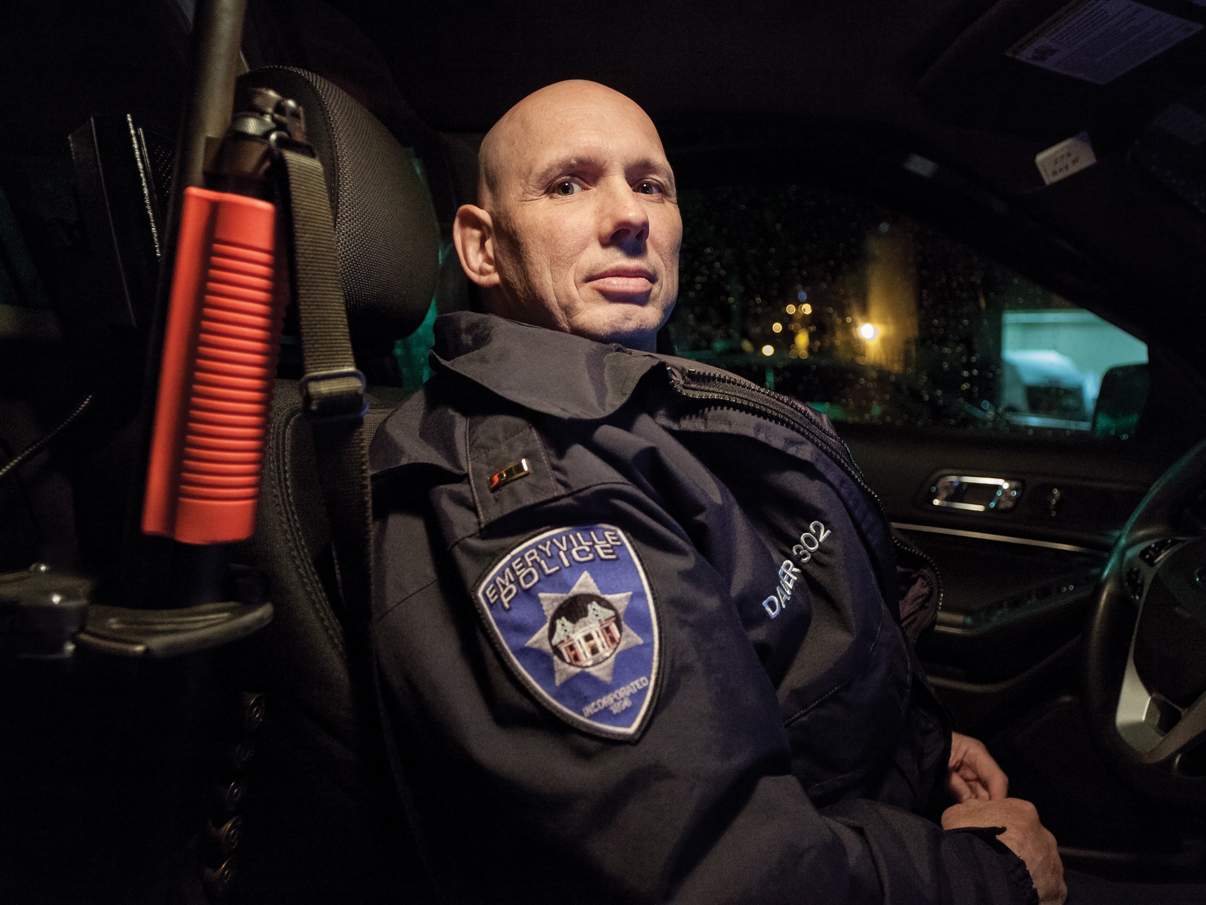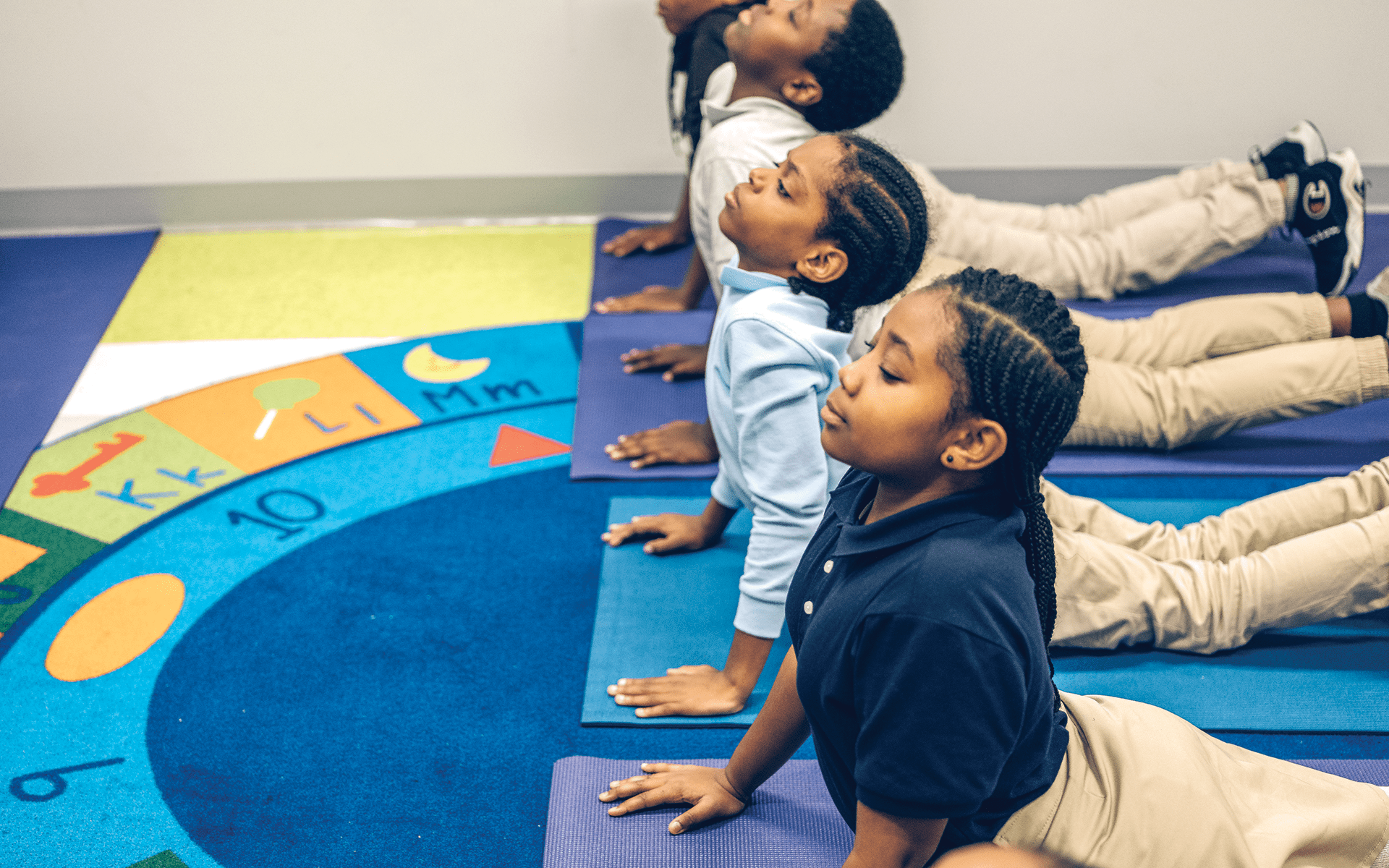You guys ready for a technique?” the trainer asks. “Everybody, sit up straight. Uncross your legs. Just look straight ahead.”
Eric White gathers his 6-foot-8 frame and straightens his back in the conference-room chair. Instead of his usual police uniform, he wears a blue polo shirt and jeans. The trainer, Don Chartrand, is visiting Emeryville, California, to talk with officers here about how to reduce their stress and build resilience with exercises like intentional breathing. “This is not anything weird,” he promises. “This is absolutely science-based.” Cops appreciate evidence, he knows, and so Chartrand has come equipped with PowerPoint graphs and lessons about heart-rate variability, the stress hormone cortisol, and how to keep the autonomous nervous system in balance.
Chartrand reassures the 18 officers that his goal is practical: boosting their performance on the beat. “It’s not about going to your happy place. This is not la-la lightweight nonsense,” he says. “I’m serious: This is blood and guts, sometimes life and death.”
He directs them to place their hands over their hearts. Some comply more eagerly than others. “Use your imagination,” he says. “It’ll sound weird. Pay attention to your breath. And imagine that the breath is flowing into your heart through your hand. Deep breaths. It’s a little odd. Now I want you to imagine that the breath is flowing through the back, the bottom, and the top of your heart, and the sides of your heart. Air is coming into your heart from all sides, 360°.”
Later, some of the officers will privately make wisecracks about the exercise. Not Officer Eric White, though. The 51-year-old former professional basketball player, a soft-spoken man with a shaved head, tries to visualize his heart receiving oxygen. And he feels it: a clean breath, carrying his stress away.

Studying Police Trauma and Mindfulness
Working in law enforcement can be life-threatening, and not just because of violent encounters. Researchers have linked policing careers to high rates of depression, PTSD, and substance abuse, along with physical ailments like sleeplessness, diabetes, and sudden cardiac death. Officers are more prone to attempt suicide than the general population, and more likely to kill themselves than get killed on duty. Plus, because police culture values stoicism, officers are often reluctant to seek out mental-health treatment.
One study of almost 2,800 white male police officers in Buffalo, New York, found their average life expectancy to be 22 years shorter than their civilian counterparts. The authors, from the University of Buffalo and the National Institute for Occupational Safety and Health, suggested that stress, trauma, obesity, shift work, and exposure to toxic chemicals might all contribute to the early deaths.
The consequences go beyond the occupational hazards. When police suffer from debilitating stress, they are more likely to exhibit problems at work, “including uncontrolled anger toward suspects,” researchers at Oregon’s Pacific University noted in a 2015 study.
Little surprise, then, that over the past few years, the United States has been rocked by repeated news reports of police killings of civilians. The highest-profile victims have been African-American men and boys: 12-year-old Tamir Rice, shot while playing with a toy gun in a Cleveland park; Eric Garner, a sometime vendor of untaxed cigarettes who died in a police chokehold in Staten Island, New York; Philando Castile, a school cafeteria worker shot during a traffic stop in Falcon Heights, Minnesota; Freddie Gray, who suffered a fatal spinal injury while shackled in the back of a Baltimore police van; and most famously, 18-year-old Michael Brown, shot six times in Ferguson, Missouri, during a tense street encounter. Castile had notified police that he legally possessed a gun; none of the rest were carrying rearms.
According to Washington Post databases, 963 people were shot dead by police in the United States in 2016, and 991 in 2015. Some of the recent killings have triggered large protests and helped give rise to the Black Lives Matter movement.
“It’s a reasonable question to ask: What is going on?” says Matthew Hunsinger, an assistant professor of psychology at Pacific University and an author of the 2015 study. “How are officers coming to make this decision to use their firearms when the black male turns out to be unarmed?”
It’s a vexing question that doesn’t lend itself to simple policy solutions. But some experts are suggesting that one way to help reduce unnecessary police violence is by improving officer wellness. “If I’m clinically depressed [and]
undiagnosed—which I would argue many of us are—and I’m struggling to even regulate my own space, how the hell do I have the capacity to have empathy?” asks Richard Goerling, a police lieutenant in Hillsboro, Oregon. “How are we supposed to navigate someone else’s suffering if we can’t even navigate our own?”
Goerling is the founder of the Mindful Badge Initiative, a consultancy that provides resilience training to first responders. (See “To Pause and Protect,” Mindful, October 2013.) He’s one of the leaders of a growing movement to introduce mindfulness practices to police departments—and, in the process, to cultivate compassion toward the communities they serve. Goerling is working with law-enforcement agencies around the country, participating in research, and helping develop a set of best practices for the young field.
“We believe this [mindfulness] training will build resilience—our ability to bounce back from stress—and resilience is going to have all sorts of downstream consequences in the community,” —Matthew Hunsinger, an assistant professor of psychology at Pacific University
Some initial findings look promising. The Pacific University study, in which Goerling took part, led 43 officers through a curriculum called Mindfulness-Based Resilience Training (MBRT), which includes meditation, martial arts, and breath- and body-awareness. (It’s a police-friendly version of Mindfulness-Based Stress Reduction.) At the end of the eight-week program, the researchers found “significant improvement” in health outcomes like stress, fatigue, and sleep quality.
“Fatigue and sleep disturbance are predictors of dysregulated mood, particularly anger,” says lead author Mike Christopher, an associate professor of clinical psychology. “And we know that anger is a big predictor of negative outcomes for police officers on the force.”
Newer, unpublished data from Pacific show a second group of officers drinking alcohol less frequently, feeling less burned out, and having fewer aggressive feelings and behaviors after undergoing training.
What remains to be learned is how these early results translate to the street. The Pacific team tried to measure whether mindfulness training can reduce implicit racial bias—“that level of bias we all have at an unconscious level,” says Christopher. They used a simulation game in which officers had to make snap decisions about whether people of different races were holding weapons (as opposed to, say, soda cans). But the officers performed so well before the training, Hunsinger says, that researchers could not measure improvement.
Still, Hunsinger feels optimistic. “We believe this [mindfulness] training will build resilience—our ability to bounce back from stress—and resilience is going to have all sorts of downstream consequences in the community,” he says. One measure psychologists use is “response inhibition,” the ability to suppress a kneejerk urge to do something harmful like reach for a gun unnecessarily. “The more resilient someone is, the better their response inhibition is going to be, because they’re going to have more cognitive resources.”
While researchers like Hunsinger and Christopher test that hypothesis in controlled studies, it’s playing out elsewhere as a natural experiment—in places like Emeryville (population 11,700), a former steel town adjacent to Oakland, where an innovative police chief is bringing some hard-earned wisdom into the workplace.
Building Resilience and Compassion on the Force
By the time Jennifer Tejada took charge of the Emeryville Police Department in September 2015, she had weathered her share of personal and professional challenges. They began during her initial police training, which she says was deliberately high-pressure. “You learn that this is part of the job: the state of being stressed, whether it’s because your uniform is not quite pressed correctly, or you weren’t able to complete your mile in six minutes,” explains the 53-year-old Ireland native. “What was missing was the coping with the stress.”
Added to that was the way officers were evaluated in the 1990s: on a “male model,” she says, that valued brawn over compassion. During her first year on the job, “I recall my sergeant calling me into the office and berating me because I would not be able to succeed in a fight with a 200-pound man in an alley,” says Tejada, who is compact and slender. With a 300-pound suspect, he told her, “you’re definitely a liability.”

Plus, there were the daily ordeals all cops face. “We see the most horrible images of people in real time,” Tejada says. She would come home from work, still reeling from her day, struggling to be a fully present mother. She felt depressed and fatigued, unable to sleep through the night. Her body was in a constant state of agitation.
Three years ago, Tejada endured a personal trauma, the details of which she doesn’t discuss publicly. She continued to function at work but would fall apart at the end of her shift. She lost weight and suffered panic attacks. Therapy didn’t help. Looking for a way to calm her mind, Tejada combed the internet and stumbled on mindfulness meditation. She tried some random online resources, then found the Headspace and 10% Happier meditation apps.
The results were profound. “It gave me back my sense of self, my sense of worth,” she says. “It allowed me to breathe.” The weight returned. She started to sleep. She felt whole, and hopeful, again.
When Tejada became Emeryville’s police chief, the department was still coping with the fallout from a recent fatal police shooting. The killing of Yuvette Henderson, a 38-year-old armed woman suspected of shoplifting and attempted carjacking, had sparked protests that briefly shut down both City Council and the Home Depot where the incident began. But things were quieter inside police headquarters. “No one talked about it,” Officer White recalls. “No one said, ‘Hey, how are you doing?’”
Shortly after arriving in Emeryville, Tejada attended a three-day Resilience Immersion Training led by Goerling—her first exposure to mindfulness that didn’t involve an app or the internet. Impressed by the workshop, she began to think about how to introduce culturally appropriate mindfulness practices to her department. She began by bringing in a former police officer, Michelle Garcia, to teach her employees yoga.
“It’s really beneficial for us to have someone who can walk in and say, ‘I’m one of you,’” Tejada says. Reactions to the class were mixed, but Captain Dante Diotalevi (the department’s second-in-command) says it flushed out some closet enthusiasts: “You look across the room, and this guy’s doing a crazy stretch, and he’s a lot more limber than you, and he says, ‘Yeah, I do it with my wife.’ You didn’t hear that before.”
Next came the breathing workshop with Don Chartrand, who used a curriculum developed by the nonprofit Institute of HeartMath. At the end of the two-hour session, officers received new iPhones loaded with both the HeartMath self-monitoring app and the 10% Happier app that had rescued Tejada.
The chief has other plans in the works, including a recovery room where officers can escape during a stressful day. She wants this calming inner work to reinforce a more compassionate, less confrontational, style of policing.
She gives the example of a bicyclist who curses out an officer and flees after being stopped for riding without a headlight. “Do we really need to have a pursuit?” Tejada asks. “And when we catch up, do we really need to grab them on their bike, take them to the ground, and handcuff them? It doesn’t fit into what we are trying to achieve in the community.”
Jennifer Tejada
Jennifer Tejada, the police chief in Emeryville, Calif, talks about overcoming resistance to meditation and similar practices on her force.
What Does Mindful Policing Looks Like?
How might this training play out, step-by-step, in the field? Goerling imagines a scenario in which police are called to a tense situation. Maybe there’s a mass protest that’s turning violent. “Before we deploy, there’s a self-awareness check,” he says. “We’re going to take a moment to do some deep breathing. We have to be aware of how we feel; we’re going to embrace the fear. We’re going to embrace, maybe, the anger at the injustice that’s occurring. But we’re not going to let those emotions interfere with our tactical, cognitive decision making.”
That’s the theory. Researchers are now trying to determine whether, in the real world, this could actually work. At the University of Wisconsin’s Center for Healthy Minds, psychologists and neuroscientists are working with the Madison Police Department to gauge the impact of an eight-week modified version of MBRT. The scientists are looking at physiological measures like heart rate and breathing, along with computer tests that measure the ability to inhibit automatic responses in the face of emotional distractions. (Think about the impulse to reach for a gun in a highly charged, but not life-threatening, situation.) They are also interviewing officers about how the training affects their relationships with family members, coworkers, and the communities they serve.
“The goal is not just to help police officers have happier and healthier lives,” says assistant scientist Dan Grupe, who is leading the study. “Nationally, we have a crisis in policing, and we have a complete breakdown of trust. It’s one of the core issues that is tearing our country apart. I don’t have any wild delusions about what we can do with this research. But the idea that we may be able to contribute, in some way, to address these larger issues is what drives me.”

Grupe says it’s too early to share results. And he warns that mindfulness training, even in a best-case scenario, won’t solve the problem. “If it gets us five percent of the way there, that’s a huge impact,” he says. But note the word if: “We’re not taking for granted that this is going to work, or that it’s going to work in a particular way. As scientists, we try to be agnostic about that. We have to look at the data and see what it shows.”
Other research has offered encouragement. In a Canadian study published last year, police were taught visualization, focused attention, and controlled breathing—then thrown into tense, lifelike scenes involving a fleeing murder suspect, a fist fight, a hostage-taker, an impending assault with a wrench, and a bystander holding a radio. “You have to stress them out in reality-based scenarios, where you increase the speed and complexity while they learn to control their stress and threat responses,” says study author Judith Andersen, an assistant professor of psychology at the University of Toronto, Mississauga. “They then gain the confidence that they can do the right thing, even under the most highly stressful situation.”
Andersen found that the trained officers made better use-of-force decisions than an untrained control group. They also had slower maximum heart rates and quicker recoveries. A fast-beating heart, the study noted, can cause irrational behavior.
Like many of her peers, Anderson believes more research is needed before police departments institute costly programs. “I do believe mindfulness and meditation have the potential for people to perceive the world in more humane ways,” she says. “You still need a rigorous study to show that translates into performance under stress.”
What’s more, a lot of factors contribute to the shootings of unarmed civilians, and some of these factors are institutional rather than personal.
“When you think about police culture at the organizational [level], there’s no wonder you have excessive uses of force,” says former federal prosecutor Kami Chavis, director of the criminal-justice program at North Carolina’s Wake Forest University School of Law. “Violence is an accepted way of dealing with certain situations. There’s also this group loyalty: This is your brother, your sister, and you have to protect them at all costs.” That loyalty can be beneficial, she says, until it interferes with better judgment.
Mindfulness could reduce unnecessary violence, Chavis adds—by helping officers self-regulate, or by serving as a check against implicit bias. To prove it, though, “we’re going to need time and longitudinal studies.”
Some departments are already starting to change their cultures. De-escalating conflict, for example, is becoming a higher priority. Mindfulness training could help reinforce this, says Alex Vitale, a sociologist who coordinates the Policing and Social Justice Project at Brooklyn College—for instance, if officers learn to carve out a few extra seconds to assess potentially dangerous situations. But it needs to be paired with that cultural shift. “Any discussion about mindfulness, about teaching officers techniques,” he says, “requires you move away from the dominant command-and-control approach: see a threat, neutralize the threat.”
The Future of the Mindful Police Movement
If mindfulness training for cops was viewed as a fringe idea just a few years ago, it’s definitely starting to gain traction now. Last year Goerling taught 670 first responders, most of them in law enforcement. In Ontario, Canada, employees of the York Regional Police are learning tai chi, journaling, and mindful leadership. The Baltimore city public schools hired the Holistic Life Foundation, a local nonprofit, to teach its police breathwork, chair yoga, and meditation during weekly drop-in sessions. In California, Menlo Park City Council spent $59,000 this year to send 29 police employees to a three-day retreat that included meditation, breathing techniques, and the neuroscience of stress.
In Tempe, Arizona, Police Chief Sylvia Moir dispatched two of her defensive-tactics trainers last year to a mindfulness retreat; they are now developing ideas for integrating what they learned into the department’s training. “I believe we will have more of our people engaged with intensive sessions,” says Moir, who this year provided her officers with meditation apps on their iPhones.
The US Secret Service and Federal Bureau of Investigation, along with police departments in cities like New York, Los Angeles, and Chicago, have used the services of Blue Courage, a training company that partners with HeartMath and incorporates elements of mindfulness into its lessons. The Washington State Criminal Justice Training Commission now provides all basic law-enforcement recruits with 16 hours of Blue Courage training.
And back in Emeryville, Tejada says her early offerings are just a prelude to a more significant shift. “One of things we’re going to do with our defensive-tactics training—where the officers are learning all the tactics they need—we are going to formally introduce the concept of mindfulness-at-the-moment,” she says. “We’re not just having conversations about it; we’re actually incorporating mindfulness meditation into the training.” It might still seem odd to some of her officers, but the chief is standing firm. “This is not a suggestion at this point,” she says. “This is what we’re doing from here on out.”
Listen to expanded interviews about how police officers use mindfulness in the heat of the moment:
Fleet Maull
Fleet Maull, who directs the Center for Mindfulness in Corrections, talks about the value of mindfulness among prison employees.
Rex Caldwell
Rex Caldwell of the Washington State Criminal Justice Training Commission, discusses the stress of responding to 911 calls and the importance of mindfulness during those events.
Jennifer “Missy” Elliott
Jennifer “Missy” Elliott, a police detective in Falls Church, Virginia, describes using mindfulness practices during a murder-suicide investigation.
read more
What Happens When Meditation Replaces Detention
This is the story of how the Holistic Life Foundation brought mindfulness and yoga to school children in West Baltimore, forever changing lives and building a community based on love and compassion.
Read More
How Mindfulness Improves Strategic Thinking
Three ways mindfulness can help leaders—and their organizations—identify important ideas.
Read More
A Compassion Practice for Healthcare Workers
In this guided loving-kindness meditation, Dr. Mark Bertin offers an opportunity to bring awareness to patterns of thinking, settle the mind, and dedicate a few minutes to self-care.
Read More






